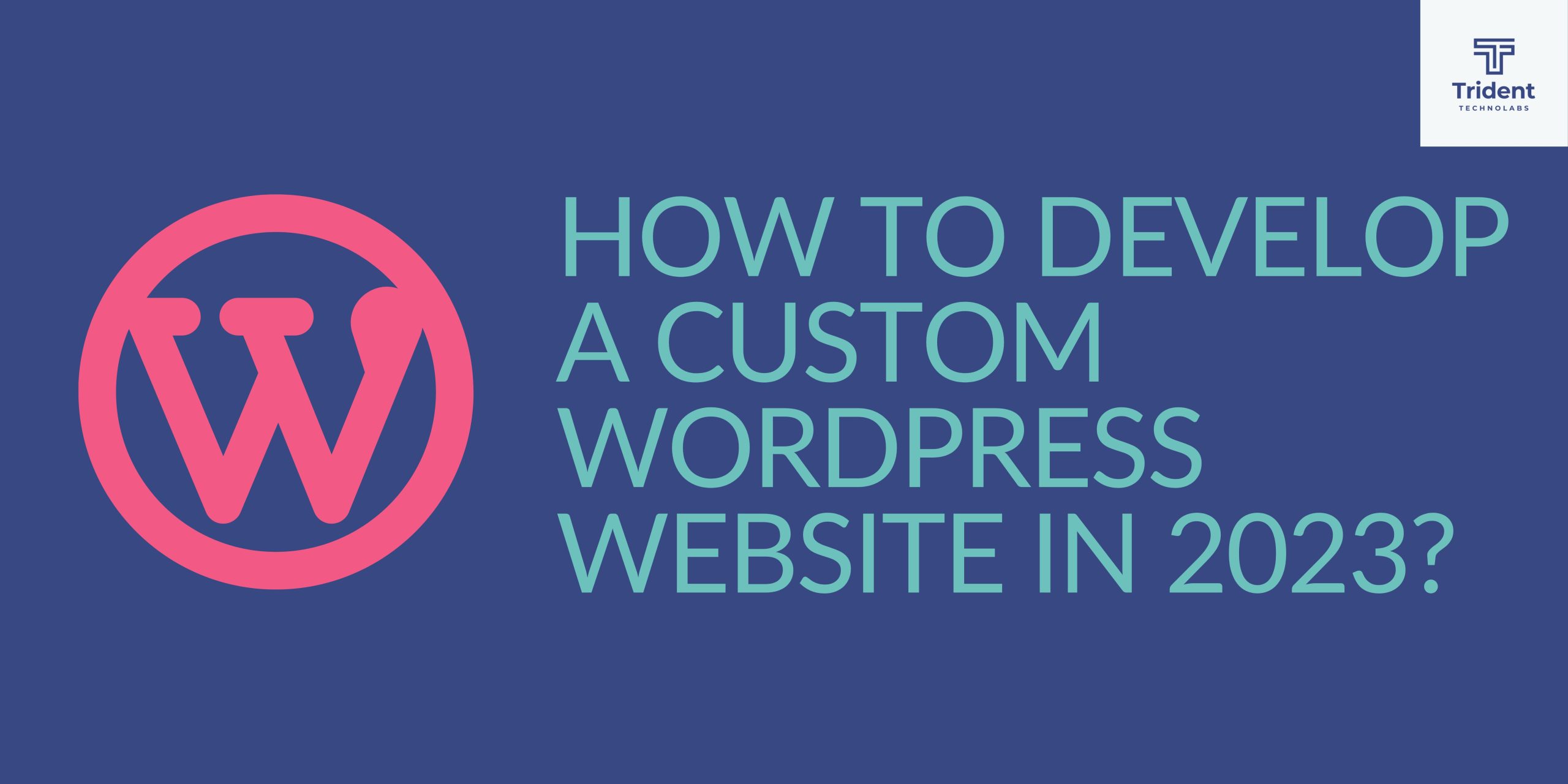
How to Develop a Custom WordPress Website in 2023? The Guide to Action
Are you a startup founder, serial entrepreneur, or head of marketing that wants to build a custom WordPress site? Or do you need a custom website for a small one-off business?
You should learn the following:
- The meaning of a custom WordPress site,
- The benefit of owning a custom WordPress site,
- The steps to develop a custom WordPress website,
- The team composition for a custom WordPress site creation process,
- The challenges of owning a website,
- And more!
Let’s discuss the points made above.
What Does Custom WordPress Website Development Stand for?
Custom WordPress development is the design and development of a site to fit the complex needs of a business, which are not achievable with a standard WordPress template.
What do we mean by this definition?
When creating a WordPress site, you can choose or buy a ready-made template and refine it with a library of plugins.
But because of the complexity of WordPress, sometimes this approach is not suitable for your startup or company. Such a site may be too slow, too buggy, or too unfriendly.
While custom website development allows you to use WordPress as the site engine, but avoid the disadvantages listed above.
How Does Custom WordPress Website Development Differ from WordPress Theme Customization?
The key difference between custom WordPress website development and the use of a ready-made template is the use of the Advanced Custom Fields plugin.
This plugin allows you to add features of any complexity to your WordPress site.
Meanwhile, WordPress theme website development is about customization of the existing template accordingly to your brand’s style.
Let’s look into each of these for a better understanding:
| WordPress Website Template Development | Custom WordPress Development |
| This only allows developers to make adjustments based on the requirements of the content management system. | As said earlier, this option is more suitable for a very complex solution. |
| Here, the web designer gets the desired template, edits it, and launches it on a WordPress sub-domain name. | It allows the implementation of custom features designed especially for achieving your business needs. |
| However, WordPress templates are generally easy to adopt and develop. Also, it’s quick, cheap, and can be built fast. | For example, we could build a real estate website with all the core functionality like advanced search by property type, number of rooms, location, and more. |
| But that usually requires hiring a team of backend and frontend developers who use more sophisticated technology than WordPress. |
But there is one more term to describe. It’s a custom WordPress theme. Let’s dive in.
What is the Difference Between a Custom WordPress Theme and a Custom WordPress Website?
A custom WordPress theme is a design file that defines what your site will look like.
If a custom WordPress site, as we’ve said, it’s a site with a set of unique features that you can create using both off-the-shelf and custom themes.
Let’s take a closer look at the advantages of creating a custom WordPress site.
What are the Advantages of Custom WordPress Website Development?
You should know the pros of developing a custom WordPress website development to help you make informed decisions about it.
Here’s a checklist of those benefits:
- The platform is secure;
- It’s easy to customize;
- It’s compatible with SEO strategies;
- It’s easy to maintain.
Let’s discuss each of those points above.
Benefit 1. Custom WordPress Sites are Secure
Custom WP sites have a single score that’s maintained by a world-class security team. See this core as the foundation through which every WordPress-backed platform stands.
The platform’s security team has over 50 experts, including security researchers and lead developers, to protect this core.
One way the core technology is kept safe is by resolving the vulnerability in the PHP XML parser. They also collaborate with the platform’s community of developers to find potential insecurities.
However, just like every other technology, it isn’t fully immune to hacks. As such, you should ensure that your custom WordPress development team does the following.
- Use 2FA and plugins to reduce login attempts;
- Add captchas to prevent hacks from bots;
- Install the WordPress security plugin and check your website from malware;
- Use SSL to protect your visitors when they connect to your website.
Benefit 2. Ease of Customization
The key to building a custom WP site is using custom fields.
These are WP-backed features that enable developers to add functionalities and additional data as desired to the platform, thus ensuring that the website is properly tailored to the technical and business needs of the site owner.
Benefit 3. SEO Compatibility
WordPress-based sites are the most compatible with search engine optimization work compared to any other technology.
The reason why is quite obvious – the WordPress market share is 43% of all websites.
The reason for its popularity is that both custom and template sites on WordPress are easy to optimize according to official (or expert) guidelines for technical SEO and on-site SEO, including sitemaps, page speed, URL structure, schema, and site navigation, and more.
Benefit 4. Ease of Maintenance
A custom WordPress site is easy to maintain. Also, the time expended on maintaining them is shorter. This is because WP updates take care of most backend maintenance processes.
In terms of cost implication, they’re relatively cheaper than non-WordPress custom sites.
For example, the cost of maintaining a non-WordPress custom e-commerce site is about $5,000/month, while the cost of maintaining a WP-based e-commerce custom website tops out at $2,000/month.
These prices should not be seen as a final cost as the exact cost varies with certain intricacies.
Now that you know the benefit of building and maintaining custom WP sites, let’s help you with the steps to developing one.
How to Develop a Custom WordPress Website?
The key to creating a successful custom WP site lies in understanding the basics. You need to have a concise idea of your goals, how to achieve them, and the expected delivery.
Here’s a checklist showing the steps to custom WordPress web development:
- Define the business goals you want to fulfill with your site,
- Create technical and business requirements that can yield your product deliverable,
- Hire a UI/UX expert or a professional web design company to help with the web design process,
- Develop the website and test it to guarantee conformity with workflow,
- Launch, maintain and perform regular updates.
Let’s discuss each point in the checklist.
Step 1. Define the Business Goals to Achieve with a Custom WordPress Site
Before you hire a WordPress developer, you need to highlight your goal.
From our years of experience creating websites, we’ve identified two important scenarios where entrepreneurs or marketers need a WordPress site. And they are:
Scenario 1. To Scale your Business
Do you own a fast-growing business that you’ll like to scale – sell online, market on social media platforms and Google?
Or do you need landing pages with contact forms, Google Analytics, and other SEO capabilities for your business ads?
If any of the questions above depicts your corporate aim, then you need a WP site. And considering the fact that over 4 billion users have access to the internet, opting for a custom site gives you access to a larger target market.
A custom WP platform gives you access to a much more significant audience in a financially prudent way while maintaining your brand touch in the domain.
Scenario 2. For Test Market Response to your Solution
According to CB Insights, the number 1 reason startups fail is that they misunderstand market demands. A way to avoid this is by developing an MVP for your idea using a WP site to test its acceptance amongst your target audience.
This gives you first-hand insight into what your audience thinks of your product, what modifications to make, and the standout features of your product.
It is financially prudent to go through this route before committing a large sum of money to develop a scaled version of your product.
Once you’ve identified your idea, the next step is to create requirements that can help bring them into existence.
Step 2. UI/UX Design
Your website design is intrinsic to fulfilling your business goals.
The UI/UX design helps transform your idea into a form that the WordPress developer can implement.
We won’t dwell much on properly designing your site, as the idea of a well-designed platform is subjective to the business goal, type, and niche.
However, it’s imperative to understand this role as it’s a foundational procedure in the overall development process.
Before commencing a design, the UI/UX designer or design agency first gathers website needs according to the business and technical requirements from the project manager and business analyst.
They then use it as a basis for mapping out the site’s features, functionality, and interface.
This stage is more fluid than others, as outputs from the design process are prone to modification. Why? This is the template from how the website would look and the basic function of the platform.
Step 3. Development and Testing
Now that there’s an interface design, the next logical step is to implement it.
This phase entails turning the design into a live website within the framework. What do we mean here? The wireframe designed by the UI/UX designer is handed over to a WP developer, who then implements the design to ensure that the website aligns perfectly with the interface made.
In some instances, there may be an interactive prototype to provide a more immersive experience on how the website functions and feels.
To ensure every actionable page is implemented within a reasonable timeframe, it’s best to set milestones with deadlines strictly. For example, you may set deadlines for the developer to complete specific features.
You should have a fully functional custom WordPress site at the end of this phase. When the website is completed, you should test it in a selected audience sample within your target market.
Adjustments are sent back to the developer for a rework.
Step 4. Product Launch, Maintenance, and Update
A crucial phase in your custom WordPress site development is launching. Once this happens, you need to monitor your platform’s visitors’ feedback.
Also, take relevant steps to implement suggestions they make. In the case of a very busy WooCommerce or blogging platform, you may need a fully functional support team to handle inquiries.
Your website maintenance needs a budget. After all, you need to sort through your budgeting right from the planning stage.
An ideal maintenance budget for your WordPress website should be %25 of your total development budget per year. Thus, if your total cost of developing your website is $50,000, you should budget a yearly maintenance cost of $12,500.
What should your goal be here? First, make sure you market your platform to ensure that many people use it. This is sacrosanct as the more users you get, the more your feedback. This, in turn, affects the level of improvement that’s possible.
Whether your site is your final product or a way to gauge consumer interest in your app, the maintenance spending is similar:
- Upgrade
- New features
- Monitoring and analytics
- Enhancement
- Support & maintenance
Let’s educate you on the proper team composition that’s needed to execute the steps above:
The Team Composition Required to Create a Custom Site on WordPress
Albeit custom WP sites are easier to develop than fully custom-made websites, it’s not all drag-and-drop as some non-technical founders perceive.
You still need a robust team of experts to create a business and technical-friendly platform. However, the exact team composition depends on your project requirement and its functionality.
Here’s a checklist of an ideal workforce for most custom projects:
- Project manager
- Business analyst
- UI/UX designer
- WordPress developer
- QA tester
- DevOps
However, even with a great team combination, you still need to be wary of some notable challenges common to custom WordPress sites.
Custom WordPress Website Development Challenges
We’ve helped develop a gamut of websites, and we’ve noticed some common challenges. Amongst these challenges are:
- Data related problems
- Plugin integration
- Slow website load time due to its complexity
Let’s dissect what each challenge entails and suggest ways to solve them.
Challenge 1. Data Related Issues
Poor or no connectivity to the database is a commonly occurring challenge for developers. This problem is often noticeable when the admin wants to modify a webpage’s content. Then you’ll see an error message that comes up with the message, “unable to connect to the database.”
This issue is often due to two reasons:
- Wrong connection data
- Server or hosting provider error
To solve the problem of wrong connection data, double-check the information you typed to ensure uniformity with required inputs. And for server or hosting provider errors, get in touch with your WordPress hosting platform for further instructions.
Another challenge to be wary of is plugin integration.
Challenge 2. Over-dependence on Plugins
Plugins are one of the major reasons why WordPress designers are so enthusiastic about WP. As of now, there are over 59,000 plugins on the platform, thus putting web builders with the potential to be overdependent on this tool.
Many non-technical web builders rely solely on these plugins since they lack the knowledge of HTML, PHP, CSS, and Javascript. And research has shown that using too many plugins makes WordPress sites slow down.
To solve this problem, it’s best to hire a web development service with technical knowledge of the requisite programming language.
Challenge 3. Slow Website
A major reason for slow loading amongst some custom WordPress sites is overloading the site with excessive content within a short timeframe.
If you publish heavy content on your website, the buildup will cause your website to have a low load time: this will, in turn, result in poor Google ranking and a high bounce rate – ultimately defeating the purpose of creating the platform.
Run your custom site on a dedicated hosting server with enough bandwidth to solve the problem. Also, regularly perform debugging activities and delete outdated materials from your site.
Use a CDN and put website caching in place.





Leave a comment: